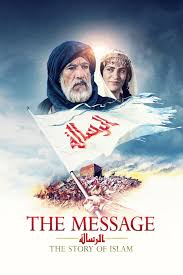
Review
A Review of the “The Message”: A Historical Epic Film
Casting: Anthony Quinn, Irene Papas, Johnny Sekka, Michael Ansara, Michael Forest, Garrick
Hagon, Damien Thomas, Michael Forest Martin Benson, George Camiller, Rosalie Crutchley,
Robert Brown, Earl Cameron, Neville Jason, Donald Burton, Andre Morell, Nicolas Amer,
John Bennet, Bruno Barnabe
Release Date: 30 July 1976 (UK)
Director: Moustapha Akkad
Art Directors: Abdel Monem Shokry, Norman Dorme
Music Composed by: Maurice Jarre
Producer: Moustapha Akkad
Based on: Prophet Muhammad (PBUH)
Cinematography: Jack Hidyard
Edited by: Jack Bloom
Production Company: Filmco International Productions Inc.
Budget: 17 million USD
“The Message”, directed and produced by Moustapha Akkad is a historical epic film that
brings the life and teachings of Prophet Muhammad (PBUH) to the big screen. The film was
released in 1976 in United Kingdom and it was also known as “Al-Risalah” offering a unique
lens to explore the beginning of Islam and the significant effect of its message to the world.
In this essay, we will review the film’s historical context and thematic exploration,
performances and character development, musical score and the overall cinematic
execution as it relates to the goals of educating audiences on the early Islamic history.
Historical Context and Thematic Exploration
“The Message” set in the 7 th century, portrays a critical era in Arabic history by outlining the
tribulation, strife and social transformation. The epic film opens with the sociopolitical
context of pre-Islamic Arabia, a society filled with conflict and a profound need for spiritual
guidance. As the story unfolds, the viewers witness the birth of Islam, which offers Islamic
teachings that advocate for equality, justice, and monotheism, the oneness of God. The
struggle faced by Prophet Muhammad (PBUH) and his companions against social injustices
forms the backbone of the film.
Moreover, the standout features of “The Messgae” is its commitments to convey the
principal tenets of Islam without depicting Prophet Muhammad directly, a requisite driven
by Islamic tradition. This choice respects religious sentiments as it allows for an exploration
of the reactions of those around Prophet Muhammad (PBUH), his family, companions and adversaries. By pointing on the experiences of these characters, “The Message” humanizes
the historical story and emphasizes the personal sacrifices made in the name of faith.
Performances and Character Development
The beauty and Strength of the “The Message” lie in its character development and
performances. The film brings to life the full range of individuals who played essential roles
in the early Islamic community through the performances of skilled role players. Anthony
Quinn, an American actor delivers a touching performance as Hamza, the prophet’s uncle,
whose transformation from a ferocious warrior to a devoted follower of Islam, summarizes
the film’s main theme of redemption.
In addition, the portrayal of female characters, particularly Hind, played by Irene Papas,
demonstrates the crucial role played by women in the early Islamic community. The
strength of Hind throughout the film illustrates how the message of Islam influenced
individuals of both genders.
Moreover, Johnny Sekka plays Bilal, a loyal companion to Prophet Muhammad (PBUH) who
symbolizes the fight for freedom in the beginning of Islam. Bilal, a pivotal character was one
of the first converts who faces persecution for his faith but despite all the difficulties, he
remains resilient and steadfast. His powerful voice, as he was the first person who gives the
Azan, the call of prayer inspires those around him, showcasing the fight against oppression
in early Islamic history.
Cinematography
Moustapha Akkad, the Director and producer of “The Messgae” makes a stunning film,
showing both historical authenticity and dramatic flair. The film was shot in the expansive
landscapes of North Africa projecting viewers in the world of 7 th century Saudi Arabia. In
addition, the battle scenes of “The Message” are particularly remarkable for their realism
and choreography, arousing the chaos and intensity of war during a changing period.
Nevertheless, it is important to note that the film reflects the values production of its time.
Some set designs and special effects may appear outdated for modern audiences. In spite of
this, “The Message” sincerity shine through as it allows to contribute meaningfully to the
discourse of faith and history.
Musical Score
The musical score composed by Maurice Jarre, plays an essential role in promoting the film’s
cultural resonance and emotional depth. The compositions of Jarre blend traditional and
orchestral Middle Eastern instruments, creating a unique soundscape that shows the rich
heritage of Arab music, and at the same time also appealing to audiences around the globe.
Besides, the score’s sweeping melodies accompany crucial moments in “The Message”,
emphasizing struggle, theme of faith and redemption. It captures the spirituality of the
story, allowing audiences to lose themselves in the historical context of Islam’s emergence.
The dynamic music complements the film’s powerful visuals by portraying the hardships
faced by early Muslim community and their unwavering commitment to their beliefs.
Ultimately, “The Message” serves as a bridge between Eastern and Western viewers by
promoting understanding of Islamic principles and teachings. The film illustrates the
significance of justice, compassion, and peace values integral to both Islam and universal
human rights. The film and its score resonate deeply, fostering dialogue and reflection that
remain relevant in today’s multicultural world.
Conclusion
To conclude, “The Message” stands as an important contribution to historical narratives and
Islamic cinema. The film’s thoughtful exploration of the early Islamic community, respect for
religious sentiments, and a commitment to portraying the profound impact of its teachings
allow it to reverberate with viewers beyond its release period. Despite the critics relating to
some production elements persist, the film’s overall aim to inspire and educate is beyond
doubt impactful.
In a challenging world that often faces division, conflicts, hatred and misunderstanding
surrounding religious beliefs, “The Messgae” offers a pathway to comprehend one of the
world’s main religions. The epic film emphasizes themes of justice, compassion, and
community striking chords that still remain relevant today. Whether one approaches the
film from a cinematic appreciation, or a space for spiritual reflection, “The Message”
provides a captivating journey that invites audiences to engage with the beauties of faith
and beliefs. As such, the film remains a timeless classic that continues to enlighten and
inspire individuals around the world.
By: Noor Muhammad Farhan Korimbocus
Write and Win: Participate in Creative writing Contest & International Essay Contest and win fabulous prizes.


